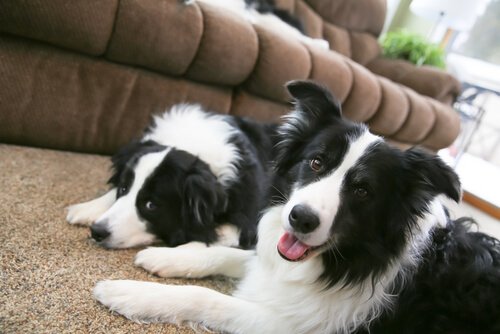How to Take Care of a Large Dog Breed

When bringing a new furry friend into our home (be it a dog, a cat, or a human) you should take into account a series of variables. Because, as you know, animals are not objects that you can just get rid of if your expectations of them are unreasonable. Many people don’t take into account the fact that their puppy might be a large dog breed and all the extra care that this will entail.
Things to consider before you adopt a large dog breed

So, you’ve decided that large dog breeds are your thing. In that case, you should definitely keep in mind the following:
- You’ll have a large dog that will grow to, at least, 45 lbs.
- The finances of your household may be affected as large dog breeds require a lot of food.
- Accessories for large dogs are more expensive; the budget of the veterinarian will also increase, etc.
- The dog requires sufficient space. So, is your house large enough for both the animal and its human inhabitants to share it and interact comfortably?
- Large dog breeds tend to be more destructive, and clumsier too. They’re seldom aware of what their tails are doing!
- If you get your large dog breed just a couple of months after they’re born, then you should pay a lot of attention to their socialization and training, as well as the basic rules of behavior expected of them. They’re a lot harder to train after they grow up. Animals are often quite sweet to their owners, but strangers would be easily intimidated by an unruly large dog.
So, if your heart is set on having a large dog, keep reading to find out about the basic care they require.
Feeding a large dog
In regard to feeding a large dog, you need to consider more than your finances. So, get advice from your vet on the best diet plan for every stage of their growth.
Keep in mind that a large dog breed puppy will grow quickly throughout the first months of their life. For this reason, there should be enough protein and calcium sources in their diet. However, you also need to make sure that their caloric intake isn’t excessive. Overweight dogs are more prone to loss of bone density and joint problems.
Also, large dog breeds grow slower than smaller ones. But a big dog’s lifespan is also shorter than a small breed –about 10 years.
Exercise and activity requirements
Large dog breeds are often highly energetic animals. Many of them were, in the past, working dogs, performing tasks such as herding, hunting, pulling carts, guarding, etc.
So, keep that in mind, and invest plenty of time taking them out for walks and allowing them to run, jump, and chase. (You might benefit from it too!) Also, consider enrolling them on a course where they can learn and practice some kind of dog sport.
It’s very important that you supply plenty of toys for your big dog. If you’d like to keep them from trying out your clothes and footwear, as well as doing lovely carvings in your garden posts, doors, or furniture legs when they get bored, that is.
Responsibilities of bringing a large dog breed into your life

Regardless of your dog’s size, the idea is to love and protect them, spoil them rotten, and to meet all of their basic needs. You alone are responsible for your dog. And, if things aren’t as idyllic as you once imagined, then you’ll just have to try and be patient, in order to teach them what you expect in your relationship with them.
You must keep in mind that adopting an animal isn’t very different from having a child. So, abandonment isn’t acceptable under any circumstance. Think carefully before adopting a pet. Are you truly willing to invest the attention, time, and money they require?
If, after reading this, you still think you want to adopt that large dog breed puppy, then remember that dog food prices and the number of hours required for activities and hygiene will logically increase as they grow up.
But, also know that if you take on the responsibility of having a pet, the love and company your animal will provide is unconditional. For sure you won’t regret it.
When bringing a new furry friend into our home (be it a dog, a cat, or a human) you should take into account a series of variables. Because, as you know, animals are not objects that you can just get rid of if your expectations of them are unreasonable. Many people don’t take into account the fact that their puppy might be a large dog breed and all the extra care that this will entail.
Things to consider before you adopt a large dog breed

So, you’ve decided that large dog breeds are your thing. In that case, you should definitely keep in mind the following:
- You’ll have a large dog that will grow to, at least, 45 lbs.
- The finances of your household may be affected as large dog breeds require a lot of food.
- Accessories for large dogs are more expensive; the budget of the veterinarian will also increase, etc.
- The dog requires sufficient space. So, is your house large enough for both the animal and its human inhabitants to share it and interact comfortably?
- Large dog breeds tend to be more destructive, and clumsier too. They’re seldom aware of what their tails are doing!
- If you get your large dog breed just a couple of months after they’re born, then you should pay a lot of attention to their socialization and training, as well as the basic rules of behavior expected of them. They’re a lot harder to train after they grow up. Animals are often quite sweet to their owners, but strangers would be easily intimidated by an unruly large dog.
So, if your heart is set on having a large dog, keep reading to find out about the basic care they require.
Feeding a large dog
In regard to feeding a large dog, you need to consider more than your finances. So, get advice from your vet on the best diet plan for every stage of their growth.
Keep in mind that a large dog breed puppy will grow quickly throughout the first months of their life. For this reason, there should be enough protein and calcium sources in their diet. However, you also need to make sure that their caloric intake isn’t excessive. Overweight dogs are more prone to loss of bone density and joint problems.
Also, large dog breeds grow slower than smaller ones. But a big dog’s lifespan is also shorter than a small breed –about 10 years.
Exercise and activity requirements
Large dog breeds are often highly energetic animals. Many of them were, in the past, working dogs, performing tasks such as herding, hunting, pulling carts, guarding, etc.
So, keep that in mind, and invest plenty of time taking them out for walks and allowing them to run, jump, and chase. (You might benefit from it too!) Also, consider enrolling them on a course where they can learn and practice some kind of dog sport.
It’s very important that you supply plenty of toys for your big dog. If you’d like to keep them from trying out your clothes and footwear, as well as doing lovely carvings in your garden posts, doors, or furniture legs when they get bored, that is.
Responsibilities of bringing a large dog breed into your life

Regardless of your dog’s size, the idea is to love and protect them, spoil them rotten, and to meet all of their basic needs. You alone are responsible for your dog. And, if things aren’t as idyllic as you once imagined, then you’ll just have to try and be patient, in order to teach them what you expect in your relationship with them.
You must keep in mind that adopting an animal isn’t very different from having a child. So, abandonment isn’t acceptable under any circumstance. Think carefully before adopting a pet. Are you truly willing to invest the attention, time, and money they require?
If, after reading this, you still think you want to adopt that large dog breed puppy, then remember that dog food prices and the number of hours required for activities and hygiene will logically increase as they grow up.
But, also know that if you take on the responsibility of having a pet, the love and company your animal will provide is unconditional. For sure you won’t regret it.
This text is provided for informational purposes only and does not replace consultation with a professional. If in doubt, consult your specialist.








